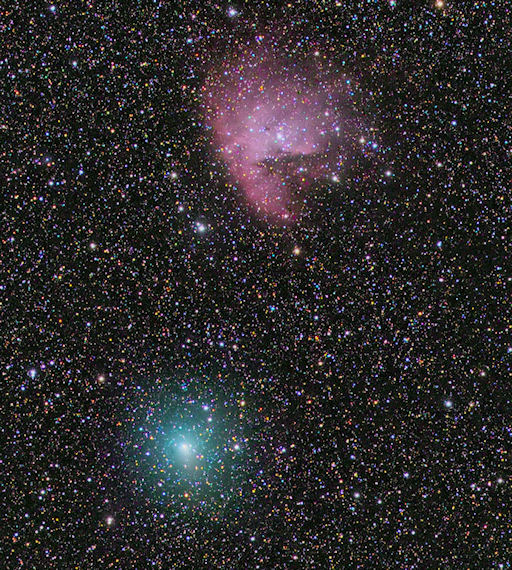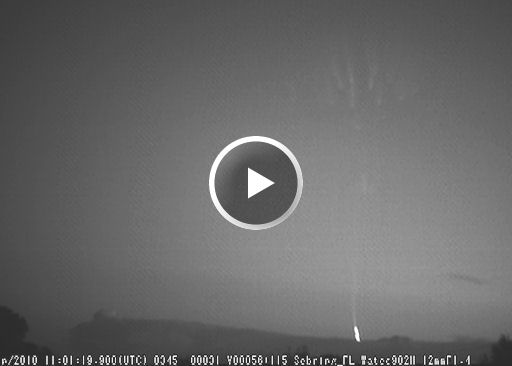AURORA ALERTS: Did you miss the Northern Lights? Next time get a wake-up call from Space Weather PHONE | | |
FARSIDE SOLAR ACTIVITY: On October 1st a bright coronal mass ejection blasted away from the far side of the sun: SOHO movie. The source appears to be a magnetic active region that formed just a few days ago, invisible from Earth because it is so far over the sun's western limb. However, NASA's STEREO-A spacecraft has a good view of the area. Stay tuned for updates.
APPROACHING COMET: Green comet 103P/Hartley 2 is approaching Earth for a close encounter on Oct. 20th. At that time, the comet will be only 11 million miles from Earth and should be dimly visible to the naked eye from dark sky sites. It already looks great through backyard telescopes:

Amateur astronomer Rolando Ligustri took this picture on Oct. 2nd using a 14-inch Global Rent-a-Scope in New Mexico. It shows Comet Hartley beside the spectacular Pacman Nebula (NGC 281), a star-forming cloud some ten thousand light years from Earth. "This is a very nice comet for telescopes and binoculars," says Martin Gembec who took a similar picture from his backyard observatory in the Czech Republic last night. "It has a [green atmosphere] almost 0.5 degrees wide and shines like a 7th magnitude star."
Two weeks after Comet Hartley has its close encounter with Earth, NASA will have a close encounter with the comet. The EPOXI spacecraft (formerly known as Deep Impact) is hurtling toward Comet Hartley now, and on Nov. 4th it will fly 435 miles from the comet's active icy nucleus. The encounter will mark only the fifth time in history that a spacecraft has been close enough to image a comet's core.
Until then, amateur astronomers can monitor the comet as it glides through the constellation Cassiopeia in the evening sky. A finder chart from Sky and Telescope shows the comet passing by a variety of stars and deep-sky objects, offering many photo-ops in the nights ahead.
more images: from Mike Holloway of Van Buren, Arkansas; from Mike Broussard of Maurice, Louisiana; from Dale Ireland of Silverdale, Washington; from Kevin Black of Winnipeg, Manitoba Canada; from Alan Dyer of near Cluny, Alberta, Canada; from Tamás Ábrahám of Zsámbék, Hungary
A GIGANTIC JET NEAR KSC: You know what comes out of the bottom of a thunder storm--lightning. But do you know what comes out of the top? On Sept. 28th at 7:01 am EDT, Joel Gonzalez photographed a gigantic jet shooting up from a storm near NASA's Kennedy Space Center. Click on the image to watch the action--and turn up the volume for a crackling soundtrack:

Gigantic jets are lightning-like discharges that spring from the top of thunderstorms, reaching all the way from the thunderhead to the ionosphere 50+ miles overhead. They're enormous, powerful, and also fairly rare. The first one was discovered in 2001 by Dr. Victor Pasko in Puerto Rico. Since then only a few dozen have been recorded, almost always over open ocean.
"This storm was just north of the Kennedy Space Center over the Atlantic," notes Gonzalez. "It was daylight already when the jet decided to fire off! Because of this, a lot of detail was lost, but if you watch the movie closely you can see hints of streamers reaching up to the ionosphere."
Because they connect thunderstorms directly to the ionosphere, gigantic jets play some role in the global flow of electricity around our planet, but how big is that role? No one knows. Investigations of gigantic jets are considered cutting-edge.
Amateur astronomers, you can contribute to this research. Check your local weather radar map for storms just over the horizon, point your meteor cameras in that direction, and click. Gigantic jets may not be as rare as we think.
more images: from Tom King of Watauga, Texas;
Sept. 2010 Northern Lights Gallery
[previous Septembers: 2009, 2008, 2007, 2006, 2005, 2004, 2002, 2001, 2000]
Potentially Hazardous Asteroids (
PHAs) are space rocks larger than approximately 100m that can come closer to Earth than 0.05 AU. None of the known PHAs is on a collision course with our planet, although astronomers are finding
new ones all the time.
On October 2, 2010 there were 1147 potentially hazardous asteroids.
Notes: LD means "Lunar Distance." 1 LD = 384,401 km, the distance between Earth and the Moon. 1 LD also equals 0.00256 AU. MAG is the visual magnitude of the asteroid on the date of closest approach. | | The official U.S. government space weather bureau |
| | The first place to look for information about sundogs, pillars, rainbows and related phenomena. |
| | Researchers call it a "Hubble for the sun." SDO is the most advanced solar observatory ever. |
| | 3D views of the sun from NASA's Solar and Terrestrial Relations Observatory |
| | Realtime and archival images of the Sun from SOHO. |
| | from the NOAA Space Environment Center |
| | from the National Solar Data Analysis Center |

